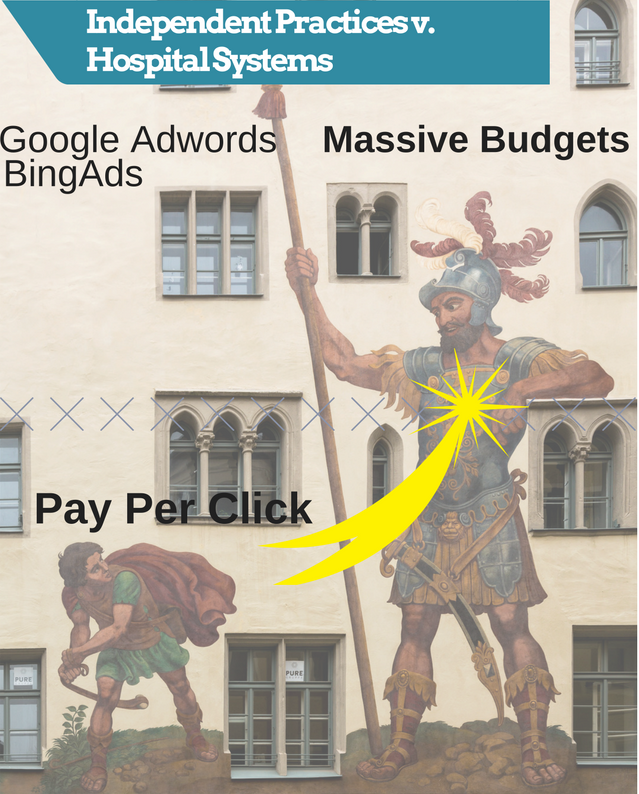Generate and Prioritize 100 Content Ideas for your Healthcare Practice Marketing in Under 60 minutes
Building your practice’s online marketing program starts by assessing whether the offline realties of your practice are accurately reflected online (and not just on your website). You need to get the lay of the land first.
Step 1 below is an outlined system to create a content plan to promote your health practice and build your patient audience.
How do Patients Find your Practice on the Internet?
Start with the obvious, non-medical, patient-speak:
The first part of creating great content is identifying what your patient audience is thinking about when they are searching for the services you provide at your hospital or practice.
Here are 4 steps to attract the type of patient-audience you are looking to build:
(1) List 10 Broad Content Topics (…specializations of your practice, why it exists)
Ask yourself: “What patients have I helped in the past? What conditions am I suited to treat, or services am I able to provide the best outcomes for?” Your list of 10 broad topics are ‘High Level’ services you provide. For example:
Example: Prospective Orthopedic patients… have torn their meniscus playing football, or elderly patients might need a total or partial knee replacement. You help repair the damage by repairing the ligament or performing a total or partial knee replacement.
Broad topics for an Orthopedic Surgeon could include: Sports Medicine, Knee, Hip, Shoulder, Back, Hand, Ankle, Foot, Wrist, Finger
List these on a spreadsheet:
Bbroad topics across a row. You won’t need to use every idea. These are starting points for creating a promotion and content plan to help the patients you want to treat find you online.
(2) List 10 Subtopics for each Broad Content Topic…(that list the patient problems associated with the conditions you treat)
Ask yourself: “What are the steps and stages of a knee injury? What are the potential conditions? Would prospective patients need or want to know about this if they want to understand and solve their knee pain?” For example:
(Broad Topic: Knee): A prospective patient you’d like to find you for their knee injury might be experiencing severe knee pain after skiing or falling:
Subtopics could be: Knee Injuries, Knee Fractures, Knee Dislocation, Knee replacement, Knee Arthroscopy Surgery, ACL Injuries, ACL Surgery, MCL Injuries, MCL Surgery, Meniscus Repair & Reattachment
List these on a spreadsheet:
Subtopics in columns beneath each broad topic row. These subtopics could all become individual pieces of content, but we’re not concerned with delivery methods or titles yet. List subtopics that provide value, that you can help people with.
10 Subtopics for each of the 10 Broad Topics will yield 100 ideas.
(3) Audit your SubTopics…(by creating a content grid to identify connections between existing and non-existing subtopic content)
Ask yourself: “Is there existing content for this idea or not? What type of content? What Blogs, Videos, Guest Posts, Lead Magnets, Products, Services, Presentations, Books, References to work you’ve done? Or pages on your website, etc. do you already have?”
(Subtopic Content for Broad Topic Knee): You might have a page on your website called “Knee Surgery”, a video performing an MCL repair, but no endorsements in the form of testimonials or mentions in the press.
The goal is to identify areas of content diversity. What else could your audience consume? Often times we find that there might be 4 blogs about MCL injuries, but then no video content; or worse a broad topic with thin, or no content.
Expand on your spreadsheet:
List all possible types of subtopic content in a column, starting with the broad topics.. Then add your list of subtopics as a row to create your content grid. For subtopic put an “x” in the intersecting row and column if you already have that type of content, if that type of content does not exist leave it blank. If you have more than one piece, add more “xx’s”.
(4) Prioritize your Content Ideas… by organizing your content grid according to your goals, and the value of your services.
Ask yourself: “Compared to the content grid, what services are most profitable and am I best equipped to perform?”
You might have plenty of (diverse) content about your success with meniscus repair, but also offer full knee replacements. Full knee replacement (being one of your most lucrative procedures) goes to the top of the list.
It’s okay to be mindful about the content you already have if you need a tie-breaker, but the focus here is to simply list the ideas associated with your services in a logical, practical, and profitable order.
Prioritize your spreadsheet:
Add a column to rank each of the 10 subtopics, prioritized by highest yield (1 highest to 10 lowest). Now compare the yield prioritized subtopics to the volume of content in your content grid. Low Content + Easiest to Produce + Highest Yield gets highest priority: Re-Rank these 1-10.
Continue to do this for the remaining broad topics. Prioritizing each subtopic by highest yield and lowest amount of content.
Nice job! You are off to a great start structuring your marketing content!
The key to step 1 is connecting and organizing content activities to enable action. If you’re to beat your competitors and become number 1 in your market for the healthcare services you provide it’s critical to develop a solid foundation on which to build.
Have questions? Please feel free to email me (see my author bio) or comment below.





